The city of Berlin, Ontario was renamed Kitchener in 1916; in 2020 the debate about changing the name once again was being revisited
Click here for previous posts about Kitchener >
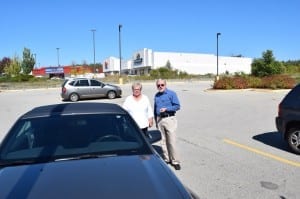
From a previous post: Lynn Legge and Scott Munro beside Lynn’s impressive Ford Mustang, prior to our respective drives home after a Sept. 24, 2014 meeting at a Boston Pizza in Kitchener. Jaan Pill photo
Starting some years ago, for a long time I’ve been working with many other people who grew up in Montreal to organize lunchtime get togethers for Malcolm Campbell High School (MCHS) students (and teachers, friends, and family members) at Mandarin restaurants in Toronto and Kitchener.
As well, some of the planning meetings for the MCHS Sixties Reunion, which took place in Toronto in October 2015, were held at a restaurant in Kitchener.

At an organizing meeting in Kitchener on June 17, 2015, for the MCHS Sixties reunion, were all set to take a photo of (left to right) Gina (Davis) Cayer, Lynn (Hennebury) Legge, and Scott Munro in the back seat of Lynn’s Mustang, but then we discovered a baby car seat was already occupying the seat! Jaan Pill photo
Recently, I’ve been making an inventory of photos I’ve taken over the years outside of Mandarin restaurants in Kitchener and Toronto – cities where we used to meet indoors for MCHS luncheons during the years before COVID.
Instead of meeting in restaurants, these days we meet for MCHS picnics in Toronto and Southwestern Ontario, when the weather is warm enough to meet outdoors.
At the current post, I’ve uploaded photos showing what a person would see walking outside the Mandarin restaurant in Kitchener.
Public history
In working on a biography project, I’ve been giving a lot of thought to the topics of public history, historical memory, and the means by which we arrive at mental pictures of events that occurred many years ago.
A key understanding that many students of history have arrived at is that many stories are actually available to us to choose from, when we seek to describe past events and processes.
The current post is concerned with the options which are available to us, when we take a look, for example, at the history of the city of Kitchener in Southwestern Ontario.
The subtext of this post is that “There is more than one version – more than one story – available to us regarding any aspect of history.” I am constantly learning new things about Kitchener and other cities in Canada.
Kitchener name change debate being revisited
A June 15, 2020 CTV News article is entitled: “Kitchener name change debate being revisited.” An excerpt reads:
In her public Facebook post, Thomas writes, “there is no room in our city for hate and the name sure does have some heavy meaning behind it.
“We should be detaching ourselves from the atrocities committed through history but instead we are glorifying those responsible.”
Thomas is urging her friends to contact their municipal representatives to express their concerns about the name Kitchener.
“There’s a lot of greys in history, and if you are going to do history in black and white, you might as well go back to school and start from the beginning, because it is not black and white,” said Mills.
Legacy of Violence: A History of the British Empire (2022)
I have previously written about Legacy of Violence: A History of the British Empire (2022) by Caroline Elkins A blurb (at the link in the previous sentence) reads:
From a Pulitzer Prize–winning historian: a searing study of the British Empire that probes the country’s pervasive use of violence throughout the twentieth century and traces how these practices were exported, modified, and institutionalized in colonies around the globe.
Sprawling across a quarter of the world’s land mass and claiming nearly seven hundred million people, Britain’s twentieth-century empire was the largest empire in human history. For many Britons, it epitomized their nation’s cultural superiority. But what legacy did the island nation deliver to the world? Covering more than two hundred years of history, Caroline Elkins reveals an evolutionary and racialized doctrine that espoused an unrelenting deployment of violence to secure and preserve the nation’s imperial interests. She outlines how ideological foundations of violence were rooted in the Victorian era calls for punishing recalcitrant “natives,” and how over time, its forms became increasingly systematized. And she makes clear that when Britain could no longer maintain control over the violence it provoked and enacted, it retreated from empire, destroying and hiding incriminating evidence of its policies and practices.
Drawing on more than a decade of research on four continents, Legacy of Violence implicates all sides of Britain’s political divide in the creation, execution, and cover-up of imperial violence. By demonstrating how and why violence was the most salient factor underwriting Britain’s empire and the nation’s imperial identity at home, Elkins upends long-held myths and sheds new light on empire’s role in shaping the world today.
Horatio Herbert Kitchener
At a previous post, I’ve shared information about research by Caroline Elkins regarding the history of the British empire, which I’ve been interested in learning about ever since I lived in Long Branch, Toronto with my family.
I began to read about the British empire because I wanted to know more about a British colonel who in 1797 had built a log cabin, the archaeological remains of which were located a one-minute walk from our house in Long Branch, Toronto where we lived for twenty-one years from 1997 until 2018, when we moved to Stratford, Ontario.
The historical record offers few details about the colonel – and certainly, no one has managed to put him on a pedestal. Given this state of affairs, it occurred to me that I would be able to learn something, at least, by picturing his life and times by reading about the history of the British empire.
When I began this study, out of curiosity about a British colonel – who was the original settler colonialist owner of all of what is now Long Branch, and a stretch of land that extended beyond Long Branch, as well – I had no idea what I was getting into – I had no idea what I would learn.
Excerpt from Legacy of Violence (2022)
An excerpt follows below from Legacy of Violence (2022). I do not have the page number as the text is from a screenshot of an e-book version of Elkins’s study; the excerpt reads:
By the fall of 1900, the British, under [Frederick Sleigh] Roberts’s command, had taken nominal control of the Boer Republic. Now the war moved into its final phase as Afrikaners adopted a highly effective guerrilla strategy. To close the war, [Horatio Herbert] Kitchener took full charge of the army as commander in chief and launched an all-out assault on an entire ethnic population: or as Kipling termed it, a “dress parade for Armageddon.” [21] The British Army introduced a new blockhouse strategy that, combined with barbed-wire fences, divided the massive interior into smaller areas. Kitchener then deployed a scorched earth policy and systematically burned crops and dumped salt to prevent future cultivation. Sweeper columns mopped up any residual Afrikaner forces. Kitchener eventually deported thirty thousand prisoners of war to remote comers of the empire. [22] British troops also razed homesteads, poisoned wells, and corralled into concentration camps Afrikaner women and children as well as African laborers.
Kitchener was drawing on imperial precedents: this was not the first time the British Empire had sought to solve a crisis through mass encampment. Since 1857 officials in India had experimented with a series of confinement measures that were as much about reform as they were about security and punishment. The Indian Mutiny had spawned the mass incarceration of twenty thousand rebellious subjects whom British officials exiled to the Andaman Islands. There, sparse tented conditions and forced labor were to impart a sense of Victorian-era rehabilitation. Indeed, temporarily separating “degenerate” and “dangerous” segments of the population from the body politic was a hallmark of nineteenth century Britain. The Poor Law of 1834 and the Habitual Criminals Act of 1869 created social categories of Britons who, like the empire’s subjects, were part of liberalism’s underbelly. It wasn’t just a matter of incarcerating these threats to society; it was also to be an exercise in reforming them through hard physical labor, thus rendering them more rational and civilized. The Raj imported these ideas through legal mechanisms – it translated Britain’s Habitual Criminals Act into India’s Criminal Tribes Act – as well as through camp systems that reflected the metaphorical language of contagion.
Click here for Encyclopedia Britannica article about Horatio Herbert Kitchener >
Mennonite history related to Kitchener
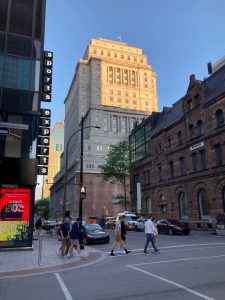
Sun Life Building, Montreal: A previous post discusses a Boer War monument located in Dorchester Square, opposite the Sun Life Building. Jaan Pill photo
At a previous post, entitled As with other histories, Mennonite history has been addressed in many ways, I’ve discussed other aspects of the history of Kitchener. The article underlines that with regard to any aspect of history, heritage, or public memory, many versions are available. An excerpt from the post reads:
This post highlights five studies about Mennonite history.
Memories about history are fluid and malleable, a product of social construction.
Personal memories are malleable.
Between fiction and nonfiction is a borderland where the two genres meet.
George Orwell
In highlighting Elkins’s view of the history of the British empire I wish to affirm that I am aligned with a point of view – regarding certain extreme political orientations, and the destruction and mayhem inevitably associated with them – enunciated very effectively by George Orwell.
After reading about Orwell recently, I have a much better understanding of the distinction between the far left and left. In particular, Why Orwell Matters (2002) by Christopher Hitchens outlines the distinction in a way that I’ve found easy to follow. Hitchens addresses the distinction in Chapter 2, “Orwell and the Left” – and elsewhere in the book as well.
An excerpt from Chapter 1, “Orwell and Empire” p. 34) in Why Orwell Matters (2002) reads:
It might not be too much to say that the clarity and courage of Orwell’s prose, which made him so readily translatable for Poles and Ukrainians, also played a part in making English a non-imperial lingua franca. In any event, his writings on colonialism are an indissoluble part of his lifelong engagement with the subjects of power and cruelty and force, and the crude yet subtle relationship between the dominator and the dominated. Since one of the great developments of his time and ours is the gradual emancipation of the formerly colonized world, and its increasing presence through migration and exile in the lands of the ‘West’, Orwell can be read as one of the founders of the discipline of post-colonialism, as well as one of the literary registers of the historic transition of Britain from an imperial and monochrome (and paradoxically insular) society to a multicultural and multi-ethnic one.


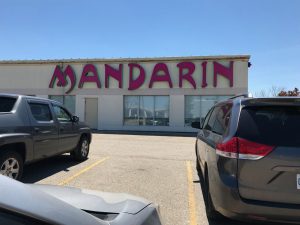
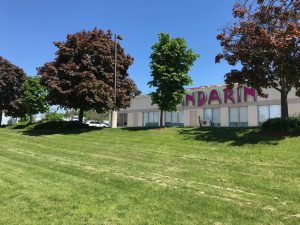







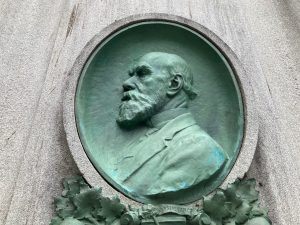
Journalism – whatever form it may take – has a relationship with public history, however pubic history may be defined (it stands in distinction, at least to an extent, from academic history).
I was interested, with regard to journalism, to read a Nov. 21, 2023 CBC article entitled: “As journalism programs across Canada face low enrolment, schools hit pause to modernize: 6 journalism programs in the country have shut down or paused admissions in last 12 months.”
An excerpt reads:
Paradigm shift needed, says UBC prof
“Not everyone agrees what those needs are. While some of the paused programs said they are updating to incorporate more multimedia courses, one Canadian professor suggests that tech isn’t the issue.
Instead, there needs to be a paradigm shift in “how we are approaching journalism as a field and what kind of journalists [we] want to train for the future of Canada,” said Saranaz Barforoush, an assistant professor of teaching at the University of British Columbia’s School of Journalism, Writing and Media.
That might mean introducing more community-focused courses, emphasizing solutions-based journalism, or introducing courses that teach students how to cover racism or marginalized communities.
I worked as a freelance writer between 1975 and 1980. That turned out to be a great form of training for all of the community organizing work and writing (in many cases community organizing and writing are inseparable pursuits) that I’ve done ever since. Among the highlights of those years was an occasion when an editor, Natalie Edwards of Cinema Canada, at a time when the magazine’s offices were on Jarvis Street in Toronto, sat down with me and proceeded to go over a draft text that I had written.
In several instances, she showed me how I could say, in a short sentence, what I had been spending a page or two of double-spaced typewritten text seeking to say. I knew I was a good writer, so I didn’t mind in the least that, speaking in a friendly, supportive tone of voice, she torn my manuscript to shreds. That was a turning point for me as a writer. That was a key formative experience for me. I owe her many thanks.
A Nov. 21, 2023 Toronto Star article is entitled: “Canadian journalism survey finds senior leadership roles still overwhelmingly filled by white men: Canadian Association of Journalists say people of colour continue to be vastly under-represented in newsrooms, in a survey of over 6,000 journalists.”
An excerpt reads:
Journalists across the country, according to the survey results, are overwhelmingly white, making up 76 per cent of newsrooms. That number increases for more senior positions — newsroom supervisors are 84 per cent white and majority male.